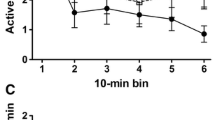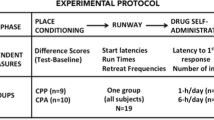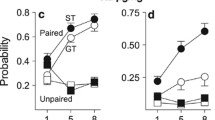Abstract
Stimulant drugs have been shown to enhance the control over behaviour exerted by stimuli previously correlated with primary reinforcers, termed conditioned reinforcers (CR). Experiment 1 examined the possible neuroanatomical specificity of the enhancement of conditioned reinforcement following intracerebral injections ofd-amphetamine. Thirsty rats were trained to associate, a light with water. In the test phase, water was no longer presented but the light (CR) was intermittently produced by responding on one of two novel levers. Rats with bilateral guide cannulae aimed at the nucleus accumbens, posterior caudate nucleus, or medio-dorsal nucleus of the thalamus received four counterbalanced microinfusions ofd-amphetamine (10, 20, 30 μg/2 μl) or vehicle (control) over 4 test days. There was a dose-dependent selective increase in responding on the lever that produced the light (CR) with intra-accumbensd-amphetamine infusions. Quantitatively similar, but much more variable effects were found with intra-caudate infusions and no effects following intra-thalamicd-amphetamine. Experiment 2 provided evidence that the enhanced control over responding by a CR with intra-accumbensd-amphetamine is behaviourally specific. Three groups of rats received a compound tone — plus —light stimulus that was positively, negatively or randomly correlated with water during training. Intra-accumbensd-amphetamine produced selective increases in responding only if the contingent stimulus had been positively correlated. The results suggest that the nucleus accumbens may play an important role ind-amphetamine's enhanced control over behaviour exerted by conditioned reinforcers.
Similar content being viewed by others
References
Beninger RJ, Hanson DR, Phillips AG (1980) The effects of pipradrol on the acquisition of responding with conditioned reinforcement: A role for sensory preconditioning. Psychopharmacology 69:235–242
Beninger RJ, Hanson DR, Phillips AG (1981) The acquisition of responding with conditioned reinforcement: Effects of cocaine, (+)amphetamine and pipradrol. Br J Pharmacol 74:149–154
Brown BB, Werner HW (1954) Pharmacological studies on a central stimulant 1(2-piperidyl)-benzhydrol hydrochloride (MRD-108). J Pharmacol Exp Ther 110:180–187
Bugelski R (1938) Extinction with and without sub-goal reinforcement. J Comp Psychol 26:121
Goldberg SR, Spealman RD, Kelleher RT (1979) Enhancement of drug-seeking behaviour by environmental stimuli associated with cocaine or morphine injections. Neurophamrmacology 18:1015–1017
Hill RT (1967) A behavioural analysis of the psychomotor stimulant effects of a drug: The interaction of pipradrol with conditioned reinforcement. PhD dissertation, Columbia University, New York, USA
Hill RT (1970) Facilitation of conditioned reinforcement as a mechanism of psychomotor stimulation. In: Costa E, Garattini S (eds) Amphetamine and related compounds. Raven, New York, pp 781–795
Jones B, Mishkin M (1972) Limbic lesions, and the problem of stimulus-reinforcementassociations. Exp Neurol 36:362–377
Kelley AE, Domesick VB (1982) The distribution of the projection from the hippocampal formation to the nucleus accumbens in the rat: An anterograde- and retrograde-horseradish peroxide study. Neuroscience 7:2321–2335
Lindvall O, Bjorklund A (1978) Organization of, catecholamine neurons in the rat central nervous system. Handb Psychopharmacol 9:139–222
Lyness WH, Friedle NM, Moore KE (1979) Destruction of dopaminergic nerve terminals in nucleus accumbens: Effects ofd-amphetamine self-administration. Pharmacol Biochem Behav 11:553–556
Mackintosh NJ (1974) The psychology of animal learning Academic, London
Mucha RF, Van der Kooy D, O'Shaughnessy, M, Bucenieks P (1982) Drug reinforcement studied by the use of place conditioning in rat. Brain Res 243:91–105
Pellegrino LJ, Cushman AJ (1967) A stereotaxic atlas of the rat brain. Century Crofts, New York
Pijnenburg AJJ, Honig WMM, Van der Heyden JAM, Van Rossum JM (1976) Effects of chemical stimulation of the mesolimbic dopamine system on locomotor activity. Eur J Pharmacol 35:45–58
Robbins TW (1976) Relationship between reward-enhancing and stereotypical effects of psychomotor stimulant drugs. Nature 264:57–59
Robbins TW, (1978) The acquisition of responding with conditioned reinforcement: Effects of pipradrol, methylphenidate,d-amphetamine and nomifensine. Psychopharmacology 58:79–87
Robbins TW, Everitt BJ (1982) Functional studies of the central catecholamines. Int Rev Neurobiol 23:303–365
Robbins TW, Watson BA, Gaskin M, Ennis C (1983a) Contrasting interactions of pipradrol,d-amphetamine, cocaine, cocaine analogues, apomorphine and other drugs with conditioned reinforcement. Psychopharmacology 80:113–119
Robbins TW, Roberts DCS, Koob GF (1983b) Effects ofd-amphetamine and apomorphine upon operant behaviour and schedule-induced licking in rats with 6-hydroxydopamine-induced lesions of the nucleus accumbens. J Pharmacol Exp Ther 222:662–673
Roberts DCS, Corcoran ME, Fibiger HC (1977) On the role of ascending catecholaminergic systems in intravenous self-administration of cocaine. Pharmacol Biochem Behav 6:615–620
Sherman JE, Roberts T, Roskam SE, Holman EW (1980) Temporal properties of the rewarding and aversive effects of amphetamine in rats. Pharmacol Biochem Behav 13:597–599
Spealman RD, Goldberg SR (1978) Drug self-administration by laboratory animals: Control by schedules, of reinforcement. Annu Rev Pharmacol Toxicol 18:313–339
Spyraki C, Fibiger HC, Phillips AG (1982) Dopaminergic substrates of amphetamine-induced place-preference conditioning. Brain Res 253:185–193
Winer BJ (1971) Statistical principles, in experimental design. Tokyo McGraw-Hill Kogakusha
deWit H, Stewart J (1981) Reinstatement of cocaine-reinforced responding in the rat. Psychopharmacology 75:134–143
Wolf G (1971) Elementary histology for neuropsychologists. In: Myers RD (ed) Methods in psychobiology, vol. 1. Academic, London New York, pp 281–300
Author information
Authors and Affiliations
Rights and permissions
About this article
Cite this article
Taylor, J.R., Robbins, T.W. Enhanced behavioural control by conditioned reinforcers following microinjections of d-amphetamine into the nucleus accumbens. Psychopharmacology 84, 405–412 (1984). https://doi.org/10.1007/BF00555222
Received:
Accepted:
Issue Date:
DOI: https://doi.org/10.1007/BF00555222




